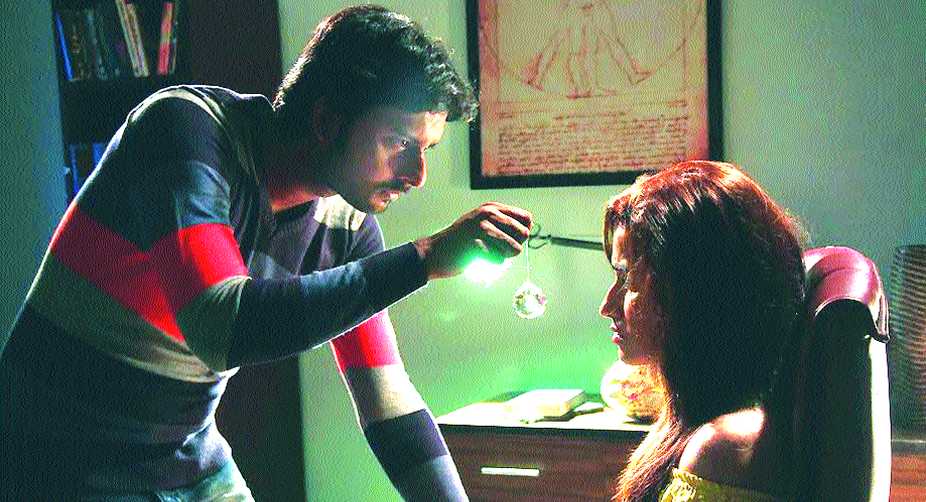CONTEMPORARY Bengali cinema has not been generous with
psychological diseases in its plotline, especially the lesser known ones. Films
like Deep Jele Jai, Hrad and Hrad Harano Sur are no longer around. In an
ambience where films are either experimental remakes of famous literary works
ranging from Saradindu Bandopadhyay to William Shakespeare, or copyrighted
remakes of Southern hits, Debarati Gupta’s Kuheli strikes an original note. It
is a psychological thriller with several layers backed by thorough research.
Kuheli tackles a little known psychological ailment called
porphyria through a story that blends the thriller-horror genres, yet not
really allowing the psychological element to dominate the narrative but with
the characters yet making a point. This is an ailment that has never been
tackled in Indian cinema till date. “My producers were keen on tackling an
original subject for my film which should throw light on something not
attempted before and yet would draw in an audience,” says Gupta, who has
directed two films earlier. The first was Hoi Choi (2013) that dealt with a
street theatre group trying vainly to grow into a movement, while Kalkiyug
(2015) was, again, a psychological thriller that went awry because eminent
actors decided to overwhelm the storyline.
Advertisement
But Kuheli is truly different. It is about a very young
couple, Sayak (Indrashish Roy) and Amrita (Pujarini Ghosh) who suddenly migrate
from Helsinki to Kolkata to settle down in a posh rental flat. Amrita, we
learn, is a patient of porphyria. What is porphyria? Put simply, it is a group
of diseases in which substances called porphyrins build up within one’s system,
affecting the skin and/or the nervous system of the afflicted. It is also known
to be an inherited disease, passed from parents to children. In Kuheli, Amrita
is a patient of acute porphyria and cannot tolerate sunlight. So, she remains
at home during the day and keeps away from socialising. Sayak is one of the
most loving husbands one has witnessed on the Indian screen. He takes extremely
good care of her and keeps her away from company and from sunlight. He cooks
breakfast, fetches her a glass of red juice from the vendor every morning,
wakes her and insists she takes her pills alongside breakfast. However, what
remains a mystery is how they manage to fund an expensive style since Sayak is
a professional blogger. Amrita’s illness is also closely linked to attacks of
selective amnesia when she forgets where she is, where she came from, which
college she went to and so on.
Debarati Gupta elaborates, “While I have worked on thrillers
before, for the first time I am bringing in a scary undertone to the thriller genre.
The film is unique in its presentation. Assuming that the film is mainly
addressed at a young audience, we have stuck to a young casting.” She laments,
however, that when she approached some familiar and noted actresses with the
offer to play Amrita, they refused on the grounds that they did not wish to be
part of a horror film.
But Kuheli is not a horror film. It is a psychological
thriller with the thriller element running right through it, like a thread
breaks strands often to venture into other areas such as past killings, the
investigation done by two intelligent police officers, an inquisitive neighbour
who has intrigue written all over her tarot readings and so on.
How the young couple copes with the issues of porphyria,
selective amnesia and panic for light forms the plot of the film. Add to this a
series of serial killings that begin soon after the couple arrives in the city.
The murders seem to be a repeat of similar killings that happened way back in
the early 1970s. But the modus operandi was the same — kidnapping the victim,
tying his/her hands behind the back, slashing the throat and draining the
entire blood from his/her system. This takes one back to vampire killings since
vampires are known to suck the blood out of their victims.
“Kaushik Sen and Anindya Pulak play investigative officers
of the Kolkata Police Department. Their characters are fleshed out so that
distinguishes them from the other characters and also from the clichéd
policemen of celluloid. Chandreyee Ghosh as the misunderstood inquisitive
neighbour has played an off-mainstream character very well. And yet we have not
steered away much from reality,” Gupta sums up.
The film touches upon the medication needed for such
patients but Sayak or even Amrita do not take any steps towards a complete
cure. One wonders why. Three lapses that stand out are – one, too many tight
close-ups of the couple in the first half that loses out on the perspective of
these frames; two, Amrita is always dressed in shorts, which makes her look very
attractive indeed but distracts the audience and attracts the male gaze much
more than the film demands; and, three, the less than average performance by
Pujarini and Sayak.
One wishes the director had ckled the illness a bit more in
depth, such as facts that the illness may be triggered by alcohol, smoking,
stress or certain medications. Amrita neither smokes nor drinks and her skin is
so smooth and peach-coloured that blisters and itching, regular symptoms for an
over-sensitive skin, are conspicuous by their absence.
“Kuheli is an entire package. It has so many layers at
different levels that it is unique, because it is not just a thriller or a
scary film, but a beautifully woven love story as well. I am extremely happy
the way the script and casting has been done. Debarati and my vision on the
film are in sync and we hope the audience will also be in sync,” says producer
Avishek Ghosh of AVMA Media LLA.
Research reveals that the mental illness of George III was
tackled in Alan Bennett’s play, The Madness of King George (1991. A British
film adapted from the play was made in 1991. The closing credits of the film
comments that the illness suffered by King George had been attributed to
porphyria and that it is hereditary. Among other descendants of George III,
theorised by the authors of Purple Secret to have suffered from porphyria, were
his great-great-granddaughter Princess Charlotte of Prussia and her daughter
Princess Feodora of Saxe-Meiningen. They uncovered better evidence that George
III’s great-great-great-grandson, Prince William of Gloucester, was reliably
diagnosed with variegate porphyria. It has been suggested that Vincent van Gogh
may have suffered from acute intermittent porphyria.
Take a bow, Debarati and Avishek, for taking courage in your
hands and dealing with a little-known subject that Indian cinema has never
witnessed. It could have been a winner had the lead artists not let you down
with their dismal performance, but for us it has been a learning experience.
By Shoma A Chatterji











